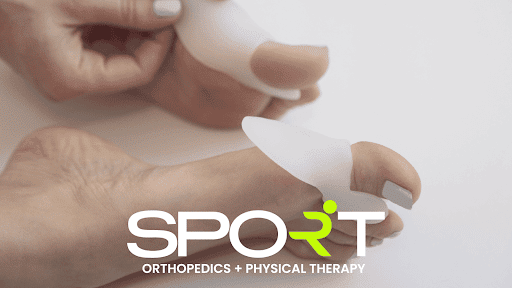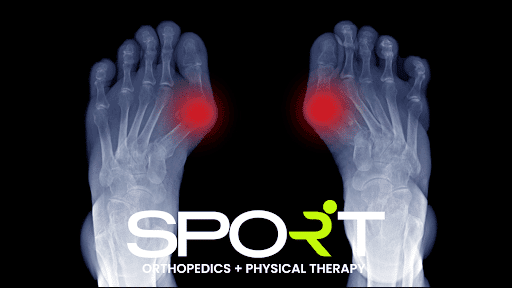
Did you know the type of shoes you wear could cause foot deformity? In most cases, having the right kind of footwear can prevent bunions and either delay foot problems or keep them from developing altogether. Even if bunions run in the family, should you buy shoes early enough, this could potentially prevent bunions from forming in the first place. Taking care of your feet is the best way to encourage healthy development and prevent the risk of developing bunions. Continue reading to learn how to prevent bunions with a few simple tips.
If you suffer from painful, irritating foot bunions, the orthopedic specialists at SPORT have a solution for you. At SPORT Orthopedics + Physical Therapy, we have extensive experience treating bunions and helping alleviate pain in our patients. To schedule an appointment with one of the best orthopedic surgeons in Dallas, please call our office at 469-200-2832 today. You can also schedule online.

Bunions are commonly referred to as hallux valgus. They can develop on the side of the foot, right beside your big toe. The joint connecting the base of your big toe forms a bony knot on the side of the foot.
Bunions form because the bones near the front of your feet fail to stay aligned properly. For most, the bones begin moving forward, out of their original placement, in order to fit better in the types of shoes you wear. Over time, the misalignment will reflect the changes in the bony framework of the front part of the foot. Eventually, the angle of the big toe will begin to curve toward the other toes.
Bunions can actually cause your big toe bone a great deal of soreness. In fact, bunion pain can become increasingly worse when wearing shoes that cause your foot structure more pressure. For example, you should avoid shoes with high heels, pointy shoes, and most importantly narrow shoes.
For some individuals, family genetics are to blame for the foot and ankle problems. Although bunions are not genetic, foot structure issues such as flat feet, fallen arches, foot deformity, and foot shape can all lead to developing bunions. This is especially true when a healthy weight is not maintained. On a daily basis, our body puts pressure on our feet. Therefore, any additional weight causes more pressure on our lower extremities.
When shoe inserts, bunion pads, and ice packs don't reduce pain, consider scheduling a consultation with SPORT Orthopedic's foot and ankle surgeons. Call (469) 200-2832 for a consultation with our Frisco, TX and Dallas, TX team of specialized orthopaedic surgeons.

Sometimes you have to do what's good for the sole. The foot sole that is.
This means taking every opportunity to prevent bunion formation or taking steps to manage bunions that have already developed. Often the most obvious solution is to wear proper shoes. The best shoes are those that fit, and have either no heel or distribute your weight evenly.
If a bunion has already formed, you should monitor your feet for changes.
Over 60% of the population currently suffers from foot problems. Of this percentage, women are more likely to be affected. It's no surprise that women are more likely to develop bunions, given that they're more inclined to wear heels or narrow shoes.
Make sure that you have properly fitting shoes that have plenty of room for your toes to rest. The right shoes will offer you good arch support and proper alignment for your individual foot shape.
Having the right shoes can make a significant impact on your overall foot health. When searching for the perfect fit, a few things should be sought out. For starters, the perfect pair of bunion prevention footwear shouldn't leave gaps or uneven space for "wiggle room." When there is too much space, toes have enough room to constantly rub together, which can lead to developing bunions.
The ideal shoes to prevent bunions should provide you the following:
The right candidate should bring you instant comfort. Generally, you will need over a week in order to break in a pair of shoes. If you're purchasing slip ons, make sure that you aren't having to shove your foot inside to make them fit.
To properly distribute the appropriate amount of pressure, arch supports are necessary. Having the properly aligned support will help take away the constant pressure on the balls or heels of your feet. Although most tennis shoes provide a relatively good arch support, some may find that if they wear over the counter shoe inserts this helps reduce or eliminate the pain caused by flat feet.
Properly fitting shoes is key if you're wanting to avoid the development of bunions. Having the right shoes includes having the right shape and size that is custom fit for your individual needs. Furthermore, consider looking for a wide toe box; having enough space in the toe box will allow toes enough space to prevent rubbing against each other. You'll want to avoid shoes that place more pressure on your instep, which lies on the top portion of your feet. For example, pointy shoes place extreme pressure on the second toe. Additionally, both narrow shoes and tight shoes place the big toe and the other toes in a tight and confined area, leaving no room to breathe.

The easiest way to reduce or eliminate pain in your big toe and big toe joint is avoiding high heels. The amount of pressure placed on the joints is intensified when wearing shoes like this. If you are unable to give up fashionable heels, consider limiting the height to 2 inches or under for bunion prevention. Another substitute is wearing blocky heels or platform shoes which better distribute the amount of pressure.
If you work in a standing or walking environment, give those feet a break. In fact, resting can help a wide array of ailments.
Even with the proper footwear for bunion prevention, our feet could use extra breaks periodically throughout the day, if possible. This happens to be beneficial for releasing built up pressure and tension.
If a bunion develops, you should take the time to stretch each foot and ankle daily. Performing exercises up to twice a day could be beneficial or bunion pain from getting worse or from bunion formation. Foot and ankle strengthening exercises can greatly reduce your risk of foot injuries.
For a total of five seconds on each foot, lift your feet off the floor. Keep your toes pointed, and then curl them as far as they will go. The same stretch can be applied to strengthen your big toe with the use of an exercise band.
While seated, take a tennis ball and roll against the bottom of each foot for up to three minutes at a time. Repeating this exercise will not only help reduce your pain and pressure, but it also will help symptoms of rheumatoid arthritis.
Place small objects on the ground and pick up the items with your feet. As you pick the object up, curl your toes to grip the object. This motion helps the big toe joint get extra exercise, all while strengthening.
Monitor and document any changes that you notice in your feet. Documenting the changes will help you narrow down the root cause of the issue and help you be aware if the issue is getting worse.

Unfortunately, some people are more prone to developing bunions.
You may have an increased risk for developing bunions if:
Once bunions begin forming on the side of the big toe joint, it is impossible to reverse the effects. If you already have a bunion and are trying to manage symptoms and reduce pain, continue reading.
The SPORT Orthopedic specialists have years of experience helping individuals with rheumatoid arthritis, prescription orthotics, and custom fitted orthotics to help reduce pain caused by hallux valgus.

Although the only permanent solution to resolve a developed bunion is surgery, there are ways to minimize soreness and reduce your pain. If surgery sounds extreme, try the following bunion treatment options:
Correcting surgery to eliminate a developed bunion is commonly referred to as a bunionectomy or metatarsal osteotomy. Typically, this operation involves repositioning bones with the use of metal screws. This helps prevent the big toe from shifting toward the other toes and ultimately to keep the big toe straight.
Bunion surgery has come a long way from the traditional operation. Previously, patients could expect a rather lengthy and painful recovery period. Luckily, the latest techniques have become minimally invasive with several positive advantages. To learn more about your surgical treatment options, contact the SPORT Orthopedic + Physical Therapy Specialists.

If you are one of the 60% of people struggling with bunion pain, call (469) 200- 2832 for a consultation with the Dallas and Fort Worth Orthopedic Specialists. The SPORT Orthopedics + Physical Therapy foot and ankle surgeons' have years of experience correcting and preventing bunions. If you're looking to reduce pain, needing help selecting prescription orthotics, or need guidance on ankle care to ensure feet and toes are aligned properly, call our Dallas and Friso orthopaedic surgeons today.








*We accept most all insurance plans, if you do not see your plan listed above or have any questions, please contact our office.

SPORT Orthopedics + Physical
Therapy – Dallas, TX
Services:
• Clinic • Orthopedic • Urgent Care
• Physical Therapy
18152 Preston Road
Suite I-2
Dallas, TX 75252
Phone: (469) 200-2832
Fax: (469) 269-1074
SPORT Orthopedics + Physical Therapy – Frisco, TX
Services:
• Clinic • Orthopedic • Urgent Care
• Physical Therapy
9255 Dallas Parkway
Suite I20
Frisco, TX 75033
Phone: (469) 200-2832
Fax: (469) 269-1074
SPORT Orthopedics + Physical
Therapy – Wylie, TX
Services:
• Clinic • Orthopedic • Urgent Care
• Physical Therapy
3400 FM 544
Suite 650
Wylie, TX 75098
Phone: (469) 200-2832
Fax: (469) 269-1074
SPORT Physical
Therapy – Prosper, TX
Services:
• Physical Therapy
790 N Preston Rd
Suite 60
Prosper, TX 75078
Phone: (469) 850-0201
Fax: (469) 269-1074
SPORT Orthopedics – Mesquite, TX
Services:
• Clinic
• Orthopedic
• Urgent Care
1102 North Galloway Ave
Mesquite, TX 75149
Phone: (469) 200-2832
Fax: (469) 269-1074